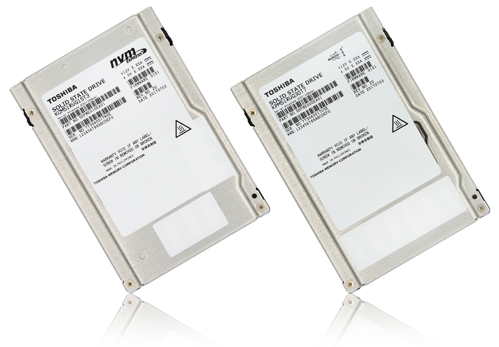Flash Memory Summit: Toshiba Unveils Enterprise 2.5-Inch PM5 12Gb SAS and CM5 NVMe SSDs With 64 Layer TLC BiCS Flash
From 400GB to 30.72TB for PM5 12Gb SAS, and from 800GB to 15.36TB for CM5 NVMe SSDs models using 64 layer, 3-bit-per-cell enterprise TLC BiCS flash
This is a Press Release edited by StorageNewsletter.com on August 16, 2017 at 2:27 pmToshiba Memory Corporation (TMC) sampling fastest [2] SAS and enterprise NVMe TLC-based SSDs.
Toshiba Electronics Europe GmbH announced the development of two enterprise SSD solutions, the PM5 12Gb/s SAS series and the CM5 NVMe [3] series.
Development is expected to be completed in the fourth quarter. Both product lines are built with TMC (Toshiba Memory Corporation)’s latest 64 layer, 3-bit-per-cell enterprise TLC BiCS Flash [4], making it possible for today’s demanding storage environments to expand the use of flash with cost-optimized 3D flash memory. With all-new, advanced features, the PM5 and CM5 series raise the bar in performance capabilities and create new opportunities for businesses to leverage the power of flash storage.
Offering up to 30.72TB [5] in a 2.5-inch form factor, the TMC PM5 series introduces a full range of endurance and capacity SAS SSDs enabling data centers to effectively address big data demands while streamlining storage deployments. With the MultiLink SAS [6] architecture, the PM5 series is able to deliver the fastest performance the market [2] has seen from a SAS-based SSD with up to 3,350 MB/s of sequential read and 2,720 MB/s of sequential write [7] in MultiLink mode and up to 400,000 random read IO/s [8] in narrow or MultiLink mode. The PM5 series’ four-port MultiLink design is an additional technology to achieve high performance, close to PCIe [9] SSDs, enabling legacy infrastructures to increase productivity without having to be re-architected from the ground up. Furthermore, PM5 SSDs support multi-stream write technology, a feature that intelligently manages and groups data types to minimize write amplification and minimize garbage collection, translating into reduced latency, improved endurance, increased performance and QoS.
As the company’s next generation NVMe SSD, the dual-port PCIe Gen3 x4 CM5 is a full-featured enterprise SSD. Like the PM5, it also supports multi-stream write technology. It is NVMe over Fabric-ready with scatter-gather list (SGL) and controller memory buffer (CMB) features.
The CMB feature uses a part of DRAM on the SSD as host-system memory, reducing DRAM used load of host-side and it enables high speed as a system. Utilizing firm’s BiCS Flash 64-layer technology, the CM5 series has performance with up to 800,000 random read and 240,000 random write IO/s for the five DWPD [10] (drive writes per day) model and up to 220,000 random write IO/s for the three DWPD model, both with a maximum power draw of 18W. Additionally, the CM5 is being used as a platform to demonstrate and to enable the ecosystem around the Persistent Memory Region (PMR) capability. PMR enables customers to augment system memory with DRAM on the SSD without the use of expensive non-volatile DIMMs (NV-DIMMs). This feature makes it possible for a single SSD solution to provide both performance storage and persistent memory to meet system performance requirements, while reducing costs by moving metadata operations, such as logging, journaling and application staging to the SSD.
“Toshiba is proud to present its new enterprise flash innovation along with the expansion of our enterprise SSD portfolio with the CM5 and PM5 series using 3D TLC FLASH. The new devices meet customer demands for greater storage capacities and application needs while leveraging the power of the latest flash memory technology“, says Paul Rowan, GM, SSD business unit, Toshiba Electronics Europe.
PM5 12Gbit/s SAS SSDs will be available in capacities ranging from 400GB to 30.72TB with sanitize instant erase (SIE) and Trusted Computing Group (TCG). CM5 NVMe SSDs will offer capacities ranging from 800GB to 15.36TB with SIE and TCG. Both TLC-based product lines offer industry standard endurance ratings with one, three and five DWPD options, and the PM5 has a ten DWPD option available.
The PM5 and CM5 series is sampling to select OEMs and was unveiled and demonstrated at the Flash Memory Summit.
[1] As of August, 2017, based on TMC survey
[2] As of August 7, 2017, based on industry-published specifications, TMC survey
[3] NVM Express and the NVM Express logo are registered trademarks, and NVMe is a trademark of NVM Express, Inc.
[4] NAND/BiCS FLASH: Product density is identified based on the maximum density of memory chip(s) within the Product, not the amount of memory capacity available for storage by the end user. Consumer-usable capacity will be less due to overhead data areas, formatting, bad blocks, and other constraints, and may also vary based on the host device and application.
[5] Definition of capacity: Toshiba Memory Corporation defines a MB (MB) as 1,000,000 bytes, a GB as 1,000,000,000 bytes and a TB as 1,000,000,000,000 bytes. A computer OS, however, reports storage capacity using powers of 2 for the definition of 1GB = 230 bytes = 1,073,741,824 bytes, 1TB = 240 bytes = 1,099,511,627,776 bytes and therefore shows less storage capacity. Available storage capacity (including examples of various media files) will vary based on file size, formatting, settings, software and OS, such as Microsoft OS and/or pre-installed software applications, or media content. Actual formatted capacity may vary.
[6] MultiLink SAS is a trademark of the SCSI Trade Association
[7] Read and write speed may vary depending on the host device, read and write conditions, and file size.
[8] IO/s: Input Output Per Second (or the number of I/O operations per second)
[9] PCIe and PCIe are registered trademarks of PCI-SIG
[10] DWPD: Drive Write Per Day. One full drive write per day means the drive can be written and re-written to full capacity once a day every day for five years, the stated product warranty period. Actual results may vary due to system configuration, usage and other factors.













 Subscribe to our free daily newsletter
Subscribe to our free daily newsletter
